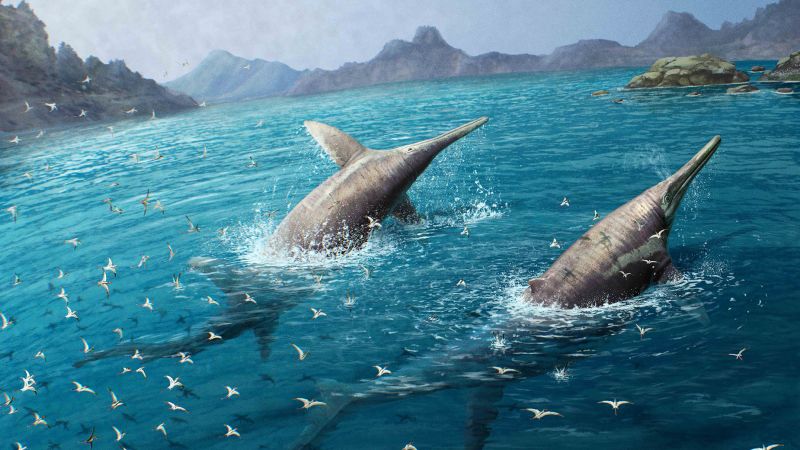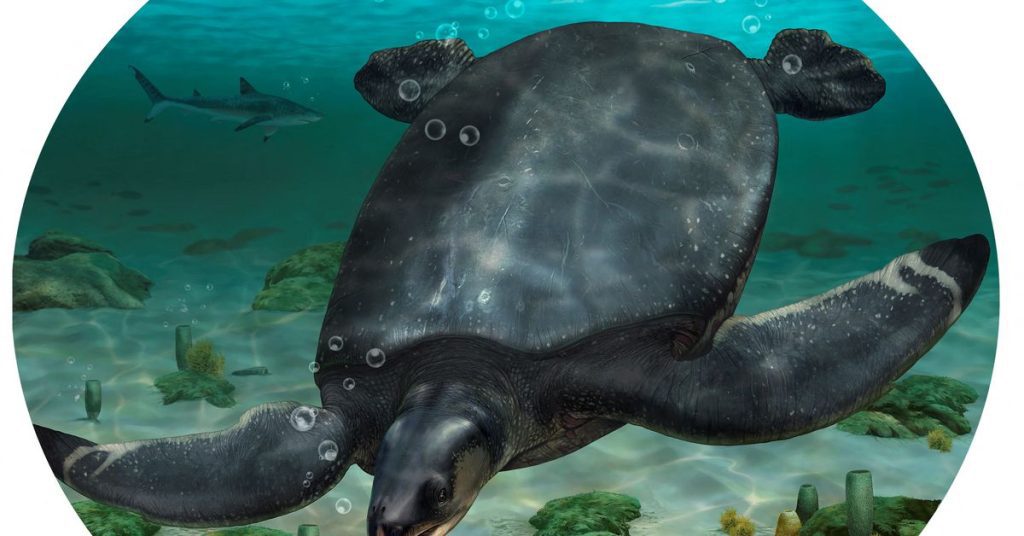(Reuters) – Sailing the subtropical seas that washed up the coasts of the archipelago that made up Europe 83 million years ago was one of the largest turtles on record, a reptile the size of a small car—a Mini Cooper to be exact—that braved the perilous waters.
Researchers on Thursday described the remains discovered in northeastern Spain of a turtle called Leviathanochelys aenigmatica that measured about 12 feet (3.7 meters) long and weighed just under two tons and lived during the Cretaceous period — the final chapter in the age of the dinosaurs. It is the largest known tortoise in Europe.
It dwarfed today’s largest turtle—the leatherback, which can reach 7 feet (2 meters) in length and is famous for its marathon sea migrations. Leviathanochelys is almost as big as the largest turtle on record – Archelon, which lived approximately 70 million years ago and measured about 15 feet (4.6 meters) in length.
“Leviathanochelys was as long as a Mini Cooper while Archelon was about the same size as a Toyota Corolla,” said paleontologist and study co-author Albert Celis of the Instituto Catala de Paleontology (ICP), a research center affiliated with Universitat Autònoma de Barcelona.
It would have been nice to be the size of a car, considering the dangerous traffic in the ancient Tethys Sea in which Leviathanochelys swam. The largest predators were huge marine reptiles with powerful jaws called mosasaurs–some exceeding 50 feet (15 meters) in length. Various sharks and rays as well as long-necked fish-eating marine reptiles called plesiosaurs also lurk.
said Oscar Castillo, a student at the University of Barcelona’s Autonomous University of Barcelona’s master’s degree program in Paleontology and lead author of the study published in the journal Scientific reports.
[1/2] This undated image shows an illustrated reconstruction of the large Cretaceous sea turtle Leviathanochelys aenigmatica, which lived about 83 million years ago and whose fossils were found in the Alt Urgell province of Catalonia in northeastern Spain. ICRA_Arts / Museu de la Conca Della – Institut Catala de Paleontologia Miquel Crusafont / Handout via REUTERS
“During the Cretaceous period, there was a tendency in sea turtles to increase their body size. Leviathanochelys and Archelon may represent the pinnacle of this process. It has been hypothesized that the reason for this increase in body size is predatory pressure, but there may be other factors,” added Castillo.
Other large turtles from Earth’s past include Protostega and Stupendemys, both of which reached about 13 feet (4 meters) in length. Protostega was a Cretaceous sea turtle that lived about 85 million years ago and, like its later cousin Archelon, inhabited the great inland sea that at that time divided North America in two. Stupendemys roamed the lakes and rivers of northern South America about 7-13 million years ago during the Miocene.
Scientists discovered the remains of Leviathanochelys near the village of Coll de Nargó in Catalonia’s Alt Urgell province after a park in the southern Pyrenees discovered fossils sticking out of the ground. So far, they’ve found parts of the back of its carapace, or shell, and most of its pelvic girdle, but no skull, tail, or limbs.
Fossils have indicated that it possessed a smooth carapace similar to leatherback turtles, with the shell itself measuring about 7.7 feet (2.35 m) long and 7.2 feet (2.2 m) wide. Leviathanochelys appears to be built for the open ocean, and rarely returns to land – eg to lay eggs.
The presence of two bony bulges on the anterior side of the pelvis differs from any other known sea turtle, indicating that Leviathanochelys represents a newly discovered lineage. It shows that gigantism in sea turtles evolved independently in separate lineages of Cretaceous North America and Europe.
Leviathanochelys aenigmatica means “mysterious leviathan turtle” due to its large size and oddly shaped pelvis, which researchers suspect is related to its respiratory system.
“Some pelagic animals[that live in the open ocean]show a modification of their respiratory system to increase their ability to breathe at great depths,” Celis said.
(Reporting by Will Dunham in Washington; Editing by Rosalba O’Brien)
Our standards: Thomson Reuters Trust Principles.

“Extreme travel lover. Bacon fanatic. Troublemaker. Introvert. Passionate music fanatic.”







More Stories
Jimmy Kimmel accuses Trump of confusing him with Al Pacino
Ancient excavations lead to the discovery of the largest marine reptiles known
“The Indian Way” – A review of “Improving Your Cuts” by RB Ramesh